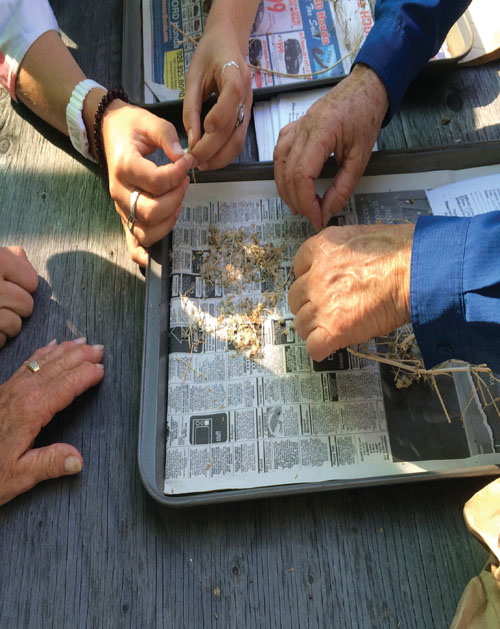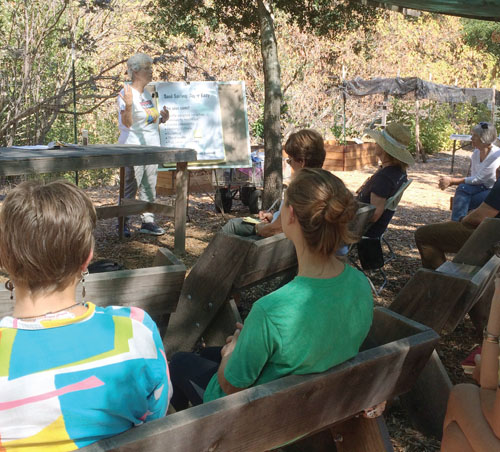 | | | Seed extraction Photo Sophie Braccini | | | | | | The Lafayette Community Garden was established five years ago and has now reached such a level of maturity and stability that the members have decided to start saving its seeds.
 Organizers invited master gardener Trish Clifford to teach a class on this topic. The very experienced Clifford showed needed techniques, including the most important of them all: preventing propagating hybrids. She also explained that saving seeds is about reproducing what works, about thriftiness and also about preserving a biological diversity that has shrunk over the past 100 years.
Organizers invited master gardener Trish Clifford to teach a class on this topic. The very experienced Clifford showed needed techniques, including the most important of them all: preventing propagating hybrids. She also explained that saving seeds is about reproducing what works, about thriftiness and also about preserving a biological diversity that has shrunk over the past 100 years.
 "It's taken us five years to build up our soil, to learn what crops best work here in Lafayette, so it seems to be the right time for us to learn how to save our seeds," says garden cofounder Beth Ferree. "Our hope is that next spring we will have a seed swap here, where people bring some of their favorite seeds."
"It's taken us five years to build up our soil, to learn what crops best work here in Lafayette, so it seems to be the right time for us to learn how to save our seeds," says garden cofounder Beth Ferree. "Our hope is that next spring we will have a seed swap here, where people bring some of their favorite seeds."
 Importance of Saving Seeds
Importance of Saving Seeds
 The eager gardeners who took the class were there for different reasons. Some said that they wanted to replant vegetables that had been good producers in their own garden next year. Students from Berkeley in charge of a school garden were motivated by their limited budget.
The eager gardeners who took the class were there for different reasons. Some said that they wanted to replant vegetables that had been good producers in their own garden next year. Students from Berkeley in charge of a school garden were motivated by their limited budget.
 "Intellectual property and seeds are becoming a big problem. This practice (saving and sharing seeds) needs to be cherished," said one participant. Clifford said that the "seed-movement" is growing. She added that gardening gets communities together and seed saving brings community resilience.
"Intellectual property and seeds are becoming a big problem. This practice (saving and sharing seeds) needs to be cherished," said one participant. Clifford said that the "seed-movement" is growing. She added that gardening gets communities together and seed saving brings community resilience.
 In the last 100 years there has been a staggering loss of food plant varieties, she said. For example there were 408 varieties of tomatoes available at the beginning of the 20th century and only 79 are left today. Ten companies own 75 percent of all commercially available seeds.
In the last 100 years there has been a staggering loss of food plant varieties, she said. For example there were 408 varieties of tomatoes available at the beginning of the 20th century and only 79 are left today. Ten companies own 75 percent of all commercially available seeds.
 "And when a big company buys a small one, it keeps those seeds that store and ship well, not necessarily those that produce the most interesting vegetable," said Clifford.
"And when a big company buys a small one, it keeps those seeds that store and ship well, not necessarily those that produce the most interesting vegetable," said Clifford.
 Collecting Seeds
Collecting Seeds
 The class focused on seeds that are easy, or rather easy to save. The first thing to learn is how to grow a plant to collect the seeds, which is not necessarily the same as growing a plant to eat it. Lettuces, for example, have to be allowed to grow their center until it spikes long green flowering stems, then the stems have to completely dry on the plant so the seeds are ripe to be collected.
The class focused on seeds that are easy, or rather easy to save. The first thing to learn is how to grow a plant to collect the seeds, which is not necessarily the same as growing a plant to eat it. Lettuces, for example, have to be allowed to grow their center until it spikes long green flowering stems, then the stems have to completely dry on the plant so the seeds are ripe to be collected.
 The process is the same with beans. "The pods themselves have to be developed and completely dried out on the plant before it is harvested," said Clifford, before passing around the dried growths.
The process is the same with beans. "The pods themselves have to be developed and completely dried out on the plant before it is harvested," said Clifford, before passing around the dried growths.
 For tomatoes, the rule is different, as one just needs to pick up a very nice and ripe fruit. For zucchinis, Clifford explained that the vegetable has to be left to grow to its full extent, and then allowed to start yellowing before it's ready to be picked up for seeds.
For tomatoes, the rule is different, as one just needs to pick up a very nice and ripe fruit. For zucchinis, Clifford explained that the vegetable has to be left to grow to its full extent, and then allowed to start yellowing before it's ready to be picked up for seeds.
 But before teaching how to save and store seeds, Clifford introduced what she feels is the most complex and important topic about saving seeds: how to avoid cross-pollination and creation of hybrids.
But before teaching how to save and store seeds, Clifford introduced what she feels is the most complex and important topic about saving seeds: how to avoid cross-pollination and creation of hybrids.
 Different species of plants cannot cross-pollinate, but different varieties of one species can. Depending how flowers get pollinated, contamination may be very hard to avoid. Clifford first reminded the audience that there are two types of flowers, perfect and imperfect.
Different species of plants cannot cross-pollinate, but different varieties of one species can. Depending how flowers get pollinated, contamination may be very hard to avoid. Clifford first reminded the audience that there are two types of flowers, perfect and imperfect.
 Perfect flowers hold both male pollen and female stigma on the same flower, while incomplete ones do not. To get pollinated and produce vegetables, those need to be pollinated by either insects such as bees, or wind. Perfect flowers have less risks of being hybridized, while it is more difficult to control the process for imperfect flowers.
Perfect flowers hold both male pollen and female stigma on the same flower, while incomplete ones do not. To get pollinated and produce vegetables, those need to be pollinated by either insects such as bees, or wind. Perfect flowers have less risks of being hybridized, while it is more difficult to control the process for imperfect flowers.
 Clifford took the example of zucchini. The male flower holds the pollen and the female flower has the stigma with a small bowl shape. Only those bare fruits. According to Clifford, and to avoid pollination of the zucchini with another member of the same species such as a pumpkin from your garden or that of your neighbor down the street, the best technique is to hand-pollinate the female flower just as it opens.
Clifford took the example of zucchini. The male flower holds the pollen and the female flower has the stigma with a small bowl shape. Only those bare fruits. According to Clifford, and to avoid pollination of the zucchini with another member of the same species such as a pumpkin from your garden or that of your neighbor down the street, the best technique is to hand-pollinate the female flower just as it opens.
 Vegetables such as beans, tomatoes, lettuces or peas are self-pollinated which reduces the risk of cross-pollination, but not completely. To be sure, there are distances that are recommended between varieties to avoid hybridization. You can also limit yourself to one variety of each species.
Vegetables such as beans, tomatoes, lettuces or peas are self-pollinated which reduces the risk of cross-pollination, but not completely. To be sure, there are distances that are recommended between varieties to avoid hybridization. You can also limit yourself to one variety of each species.
 Storage
Storage
 Seeds can be stored in a glass container when the plant has dried up. For tomatoes, you will want to pick up a fully ripe fruit, and remove seeds - the fruit can still be eaten.
Seeds can be stored in a glass container when the plant has dried up. For tomatoes, you will want to pick up a fully ripe fruit, and remove seeds - the fruit can still be eaten.
 "You have to get rid of the little gel pack the seeds are in," says Clifford. "You put it in a little jar with a little bit of distilled water and you will want it to ferment a bit for a few days to break down the gel pack and give the seeds a little bit of disease resistance." The seeds have then to be dried out on paper in a cool aerated place before they are stored.
"You have to get rid of the little gel pack the seeds are in," says Clifford. "You put it in a little jar with a little bit of distilled water and you will want it to ferment a bit for a few days to break down the gel pack and give the seeds a little bit of disease resistance." The seeds have then to be dried out on paper in a cool aerated place before they are stored.
 "Never plant all your seeds in one year," warns Clifford, because if it is a bad year you might lose it all. If seeds are kept at cool temperature and low moisture, they can last years.
"Never plant all your seeds in one year," warns Clifford, because if it is a bad year you might lose it all. If seeds are kept at cool temperature and low moisture, they can last years.
 Clifford said that the seed saving class was developed with the Richmond's seeds lending library, part of the Richmond library. In this project, people get free seeds and return some a year later after they've grown the vegetable and saved some for the seeds. For more information visit www.richmondgrowsseeds.org. She added that more than 300 seed-lending-libraries have used their process to set-up their own groups, all participating in the full circle of gardening.
Clifford said that the seed saving class was developed with the Richmond's seeds lending library, part of the Richmond library. In this project, people get free seeds and return some a year later after they've grown the vegetable and saved some for the seeds. For more information visit www.richmondgrowsseeds.org. She added that more than 300 seed-lending-libraries have used their process to set-up their own groups, all participating in the full circle of gardening.
 The Lafayette Community Garden, located at 3932 Mt Diablo Blvd., Lafayette, is managed by 50 family volunteers who sign up for one year. The location and signup period is now open and all information can be found on the garden's website at www.Lafayettecommunitygarden.org. Classes open to the public are offered year round.
The Lafayette Community Garden, located at 3932 Mt Diablo Blvd., Lafayette, is managed by 50 family volunteers who sign up for one year. The location and signup period is now open and all information can be found on the garden's website at www.Lafayettecommunitygarden.org. Classes open to the public are offered year round.

|

